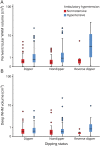White matter hyperintensities mediate the association of nocturnal blood pressure with cognition
- PMID: 32295824
- PMCID: PMC7274843
- DOI: 10.1212/WNL.0000000000009316
White matter hyperintensities mediate the association of nocturnal blood pressure with cognition
Abstract
Objective: To test the hypotheses that hypertension and nocturnal blood pressure are related to white matter hyperintensity (WMH) volume, an MRI marker of small vessel cerebrovascular disease, and that WMH burden statistically mediates the association of hypertension and dipping status with memory functioning, we examined the relationship of hypertension and dipping status on WMH volume and neuropsychological test scores in middle-aged and older adults.
Methods: Participants from the community-based Maracaibo Aging Study received ambulatory 24-hour blood pressure monitoring, structural MRI, and neuropsychological assessment. Four hundred thirty-five participants (mean ± SD age 59 ± 13 years, 71% women) with available ambulatory blood pressure, MRI, and neuropsychological data were included in the analyses. Ambulatory blood pressure was used to define hypertension and dipping status (i.e., dipper, nondipper, and reverse dipper based on night/day blood pressure ratio <0.9, 0.9-1, and >1, respectively). Outcome measures included regional WMH and memory functioning derived from a neuropsychological test battery.
Results: The majority of the participants (59%) were hypertensive. Ten percent were reverse dippers, and 40% were nondippers. Reverse dipping in the presence of hypertension was associated with particularly elevated periventricular WMH volume (F 2,423 = 3.78, p = 0.024) and with lowered memory scores (F 2,423 = 3.911, p = 0.021). Periventricular WMH volume mediated the effect of dipping status and hypertension on memory (β = -4.1, 95% confidence interval -8.7 to -0.2, p < 0.05).
Conclusion: Reverse dipping in the presence of hypertension is associated with small vessel cerebrovascular disease, which, in turn, mediates memory functioning. These results point toward reverse dipping as a marker of poor nocturnal blood pressure control, particularly among hypertensive individuals, with potentially pernicious effects on cerebrovascular health and associated cognitive function.
© 2020 American Academy of Neurology.
Figures


Comment in
-
Reader Response: White Matter Hyperintensities Mediate the Association of Nocturnal Blood Pressure With Cognition.Neurology. 2021 Jul 6;97(1):44-45. doi: 10.1212/WNL.0000000000012214. Neurology. 2021. PMID: 34226284 No abstract available.
-
Reader Response: White Matter Hyperintensities Mediate the Association of Nocturnal Blood Pressure With Cognition.Neurology. 2021 Jul 6;97(1):45. doi: 10.1212/WNL.0000000000012216. Neurology. 2021. PMID: 34226285 No abstract available.
-
Author Response: White Matter Hyperintensities Mediate the Association of Nocturnal Blood Pressure With Cognition.Neurology. 2021 Jul 6;97(1):46. doi: 10.1212/WNL.0000000000012217. Neurology. 2021. PMID: 34226286 Free PMC article. No abstract available.
References
-
- Henskens LH, Kroon AA, van Oostenbrugge RJ, et al. . Associations of ambulatory blood pressure levels with white matter hyperintensity volumes in hypertensive patients. J Hypertens 2009;27:1446–1452. - PubMed
Publication types
MeSH terms
Grants and funding
LinkOut - more resources
Full Text Sources
Medical
